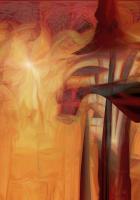When the twigs of barberry bushes arch with the weight of clusters of beautiful bright berries in September, everyone must take notice of a shrub so decorative, which receives scant attention from us, however, when its insignificant little flowers are out.Yet these blossoms, small as they are, are up to a marvelous trick, quite as remarkable as the laurel's (q.v.) or the calopogon's (q.v.), to compel insects to do their bidding.
Three of the six sepals, by their size and color, attend to the advertising, playing the part of a corolla; and partly by curving inward at the tip, partly by the drooping posture of the flower, help protect the stamens, pistil, and nectar glands within from rain.Did the flowers hang vertically, not obliquely, such curvature of the tips of sepals and petals would be unnecessary.
Six stamens surround a pistil, but each of their six anthers, which are in reality little pollen boxes opening by trap-doors on either side, is tucked under the curving tip of a petal at whose base lie two orange-colored nectar glands.A small bee or fly enters the flower: what happens? To reach the nectar, he must probe between the bases of two exceedingly irritable stamens.The merest touch of a visitor's tongue against them releases two anthers, just as the nibbling mouse all unsuspectingly releases the wire from the hook of the wooden trap he is caught in.As the two stamens spring upward on being released, pollen instantly flies out of the trap-doors of the anther boxes on the bee, which suffers no greater penalty than being obliged to carry it to the stigma of another flower.So short are the stamens, it is improbable that a flower's pollen ever reaches its own stigma except through the occasional confused fumbling of a visitor.
Usually he is so startled by the sudden shower of pollen that he flies away instantly.
In the barberry bushes, as in the gorse, when grown in dry, gravelly situations, we see many leaves and twigs modified into thorns to diminish the loss of water through evaporation by exposing too much leaf surface to the sun and air.That such spines protect the plants which bear them from the ravages of grazing cattle is, of course, an additional motive for their presence.Under cultivation, in well-watered garden soil - and how many charming varieties of barberries are cultivated - the thorny shrub loses much of its armor, putting forth many more leaves, in rosettes, along more numerous twigs, instead.Even the prickly-pear cactus might become mild as a lamb were it to forswear sandy deserts and live in marshes instead.Country people sometimes rob the birds of the acid berries to make preserves.The wood furnishes a yellow dye.
Curiously enough it is the EUROPEAN BARBERRY that is the common species here.The AMERICAN BARBERRY (B.Canadensis), a lower shrub, with dark reddish-brown twigs; its leaves more distantly toothed; its flowers, and consequently its berries, in smaller clusters, keeps almost exclusively to the woods in the Alleghany region and in the southwest, in spite of its specific name.
SPICE-BUSH; BENJAMIN-BUSH; WILD ALLSPICE; FEVER-BUSH(Benzoin Benzoin; Lindera Benzoin of Gray) Laurel family Flowers - Before the leaves, lemon yellow, fragrant, small, in clusters close to the slender, brittle twigs.Six petal-like sepals; sterile flowers with 9 stamens in 3 series; fertile flowers with a round ovary encircled by abortive stamens.Stem: Asmooth shrub 4 to 20 ft.tall.Leaves: Alternate, entire, oval or elliptic, 2 to 5 in, long.Fruit: Oblong, red, berry-like drupes.
Preferred Habitat - Moist woodlands, thickets, beside streams.
Flowering Season - March-May.
Distribution - Central New England, Ontario, and Michigan, southward to Carolina and Kansas.
Even before the scaly catkins on the alders become yellow, or the silvery velvet pussy willows expand to welcome the earliest bees that fly, this leafless bush breathes a faint spicy fragrance in the bleak gray woods.Its only rivals among the shrubbery, the service-berry and its twin sister the shad-bush, have scarcely had the temerity to burst into bloom when the little clusters of lemon-yellow flowers, cuddled close to the naked branches, give us our first delightful spring surprise.All the favor they ask of the few insects then flying is that they shall transfer the pollen from the sterile to the fertile flowers as a recompense for the early feast spread.Inasmuch as no single blossom contains both stamens and pistil, little wonder the flowers should woo with color and fragrance the guests on whose ministrations the continuance of the species absolutely depends.
Later, when the leaves appear, we may know as soon as we crush them in the hand that the aromatic sassafras is next of kin.But ages before Linnaeus published "Species Plantarum" butterflies had discovered floral relationships.












